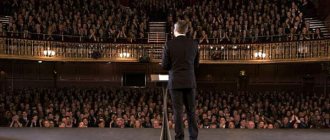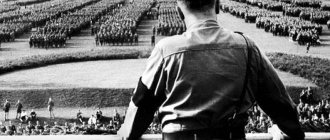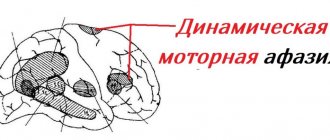When a speaker goes on stage in front of an unfamiliar audience, which in turn sees this speaker for the first time, an impenetrable wall of uncertainty and mistrust automatically arises between them. At this moment, the audience looks at the speaker from head to toe, evaluates his appearance, his facial expressions, his demeanor and automatically forms a certain preliminary opinion about him from the meager data that they have. This opinion is not final, it can be neutral, positive or negative, but it will determine how easy it is for the speaker to connect with the audience during a public speech and win them over.
When performing in front of a new audience, the most important time is the first and last minutes, since the beginning and end of the performance are most vividly remembered by the viewer.
Thus, before the start of the speech, the following situation arises: the speaker has not yet opened his mouth, but the audience already has some attitude towards him and expects something from him. Some spectators assumed a defensive posture and were ready to question every word they heard and explode with schadenfreude in response to every mistake of the speaker. Others sympathize with the speaker and are ready to support him. Still others are simply waiting to see what happens next. The first minutes of the speech are the most important, so the speaker must have time to:
- Win over the skeptics.
- Justify the trust of fans.
- To interest and captivate expectant people.
- Hold the attention of the audience and lead them along the “steps” of the prepared speech.
Introduction
Establishing contact with the audience begins with the formation of eye contact. I will give the most primitive example, which will immediately clarify why it carries such great significance. Tell your loved one "I love you." Do this three times. The first time - looking straight into the eyes, the second time - looking somewhere to the side, the third time - looking at another person. After each such confession, pay attention to what this person’s reaction will be to your words. Just try it and you will see how much eye contact increases the significance of your words in the eyes and mind of the interlocutor.
The same approach applies to public speaking, and all for one simple reason: the optic nerve is about 50 times thicker than the auditory nerve. It is through visual images, that is, with the help of our eyes, that we absorb about 90% of all information about the world around us. It is your view of the public that determines how they perceive you. Often, a speaker's eyes reveal more information about him than his speech.
ADVICE. This material is a logical continuation of the articles “Fear of Public Speaking”, “Preparation for Public Speaking” and “Structure of Public Speaking”. For a more complete and in-depth understanding of the topic, I recommend that you also read it.
Competent visual component at a presentation, training, conference
Public speeches are often accompanied by visuals that display footage of the visual component of the speech. Without visualization, trainings, seminars, conferences are practically impossible, and for presentations the visual component is the main one.
First of all, it should be informative, but not overloaded. Viewers should not forget about the speaker and read the text on the screen. It’s ideal to take an example from Steve Jobs: “one slide, one thought . At the same time, you should not be overzealous with fonts and colors - this will create unnecessary visual noise. Let's find out what else is important to consider in the presentation to get the maximum effect.
The Right Type of Visualization
Beautiful - that's understandable. The biggest loss of credibility in your key message is if it is poorly visualized. The chosen method of presenting information should not distort it or make it difficult to understand.
Lighten the frame as much as possible
Statistics come in handy in a presentation, but don’t oversaturate your staff with information. 1-2 images per slide is enough. Cut out the fluff and make sure the data reinforces your message, not the other way around.
Support data with images
It is better to support dry numbers with images to achieve the desired effect. Sometimes images can replace words and reinforce the message.
Data should be easy to compare
If the purpose of the slide is to show the relationship between different groups of data, they should be as convenient as possible to compare.
Clarify and simplify
The design should not make it difficult to understand, it should immediately make it clear what it is about. If this does not happen, you need to look for another way to illustrate the information.
Arrange data in a logical sequence
Intuitive order makes it easy to understand. The listener will spend less time and effort reading information if he quickly understands the principle of its arrangement. Take care of the participant - arrange the data either in alphabetical order, or from smallest to largest or vice versa. Also consider the best arrangement - top to bottom or left to right.
As simple as possible
Minimalism is the best approach to preparing a presentation. Avoid images with cast shadows and cluttered elements. The simpler the better.
Where does the performance begin?
As I discussed in the previous article, “The Structure of Public Speaking,” the initial phase of any such event is establishing contact with the audience. Here we will figure out how to achieve the same effect, but almost without words. To do this, it is necessary to give your face a friendly look with a slight smile when going out to the audience. As usual, it is important not to overdo it, not to squeeze it out of yourself and not to stretch your mouth to your ears, otherwise your falsehood will be extremely obvious. Be natural and sincere in expressing your feelings.
Once in front of the public, take your time to look at everyone present. Take a quick look at the faces and try to look into the eyes of literally each of them. If you catch a glance from someone sitting in the hall, nod slightly in response to emphasize that you noticed it. Even if you see everyone present for the first time and none of them is familiar to you, noting their eyes with your quick glance, you thereby establish subconscious contact with them. Then, during the entire event, this contact will remain quite firmly. This is exactly how the initial contact with the audience should be.
Establishing contact with the audience
As we have already found out, establishing eye contact, speaking in the language of analogies, is not chaotic bombing, but targeted missile strikes. It is useless to try to establish contact with the entire audience, because this is simply impossible. Instead, make eye contact with everyone in the audience. You may think that this may take quite a lot of time and will distract you from the main task, but in practice, everything is much simpler. Our eyes can move at incredible speeds, allowing you to change direction in just a split second. Give literally a split second to every glance you meet from the audience, so you can establish contact and reach a large number of listeners in a short period of time. Your task is to glide over your eyes, but not to linger on them.
In the first seconds of your speech, when you instantly skim across faces and establish contact with the audience, namely with those listeners who are already looking at you. Then those who usually fiddle with their phones or tablets during such events also raise their eyes. The moment you begin your speech, they will raise their eyes and you will meet them with yours. After such eye contact, when a person sees your oncoming gaze, he will subconsciously conclude that you see him among the entire crowd and may even be following him. This will encourage him to listen to you more attentively and no longer lower his eyes back to the gadget. Next, during the speech, wait for the moment when those listeners who are not accustomed to looking at the speaker at all raise their eyes. No matter what they do while listening to you, sooner or later they will raise their eyes and, having discovered your oncoming gaze, they will not lower them for a long time.
Speaker
"Speaker" is a word with many meanings. The word can be defined as:
- a person who gives a public speech;
- a person who has the gift of eloquence.
For a lecturer speaking in front of an audience, there are a number of important criteria, without which the speech may be ineffective.
Requirements for a speaker
For a speaker to be successful with his audience, firstly, he must be neat and well dressed. It is advisable that the clothes do not contain bright details and are not variegated colors or unusual styles. You should always keep things clean.
Secondly, the personal and behavioral qualities of the speaker are important. The lecturer should not make unnecessary movements of a mechanical nature, as this distracts the audience. The speaker's posture matters: the lecturer must stand confidently. Uncertainty or unnecessary swaying can negatively affect the audience's attitude.
Thirdly, you need to maintain eye contact with the audience: during the report, do not be distracted by extraneous things, do not look back, do not look out the window. The main thing is that you need to look at the audience with interest, since lecturers who look at their listeners with an absent look are usually more difficult to perceive. There is no need to take in the entire hall at once; it is enough to move your gaze from one part of the hall to another.
It is advisable that the speaker does not read the material from a piece of paper, but reproduces it from memory, since then the public’s perception of the material improves noticeably.
Establishing contact between the speaker and the audience
The most important factor in any public speech is establishing contact with the audience. If it is not there, the effectiveness of the performance is practically non-existent.
Feedback from the speaker to the audience represents the commonality of the emotional state of the audience with the lecturer. Mutual understanding and intellectual empathy are also important - the unity of the speaker’s thoughts with the public’s thinking.
The thought process must develop simultaneously in the speaker and the audience: only then will the listeners be able to fully comprehend what the speaker is saying.
It is also necessary that the speech evokes similar feelings in the speaker and the listeners. This is a consequence of the attitude of the speaker himself to the subject of speech. An emotional response from the audience will be present if the speaker:
- genuinely interested in the subject of the story;
- presents the material in an accessible way;
- convinced of the reliability and importance of the information presented;
- respects listeners and recognizes them as partners.
You can easily establish the degree of contact - how much the speaker and his audience interact. Usually during a performance the hall is quiet. However, this silence is polite or working.
In one audience, people react to the words of the speaker, express their attitude towards the words of the speaker, and are afraid to miss every word. This is evidenced by their emotional responses to jokes, addresses, as well as their posture (usually it is concentrated).
In another room, people may not listen to the speaker, even if outwardly it is also quiet. In such a community, listeners do not want to disturb the speaker, thinking about their concerns and affairs.
Therefore, silence is not a criterion for assessing the degree of contact between the speaker and the audience.
How to achieve mutual understanding with listeners
The main factors of mutual understanding include:
- reaction of listeners to the speaker’s speech (laughter, exclamations, applause);
- the speaker's confidence in his own speech (a person who knows how to build contact with listeners speaks clearly and confidently);
- relevance of the information presented (its novelty, understandability, importance, interest);
- the personality of the speaker (the reputation of the speaker, the degree of his erudition and attractiveness matter, it is also important whether he is principled).
Often the speaker manages to establish contact only with a fraction of the audience. This attention of people becomes constant or variable, stable or unstable. It all depends on the specifics of the issue being discussed, the degree of its relevance and the level of preparation of the public.
To establish rapport with the audience (when the speaker and the audience are one), the speaker must take into account the social status and level of development of the audience.
Mistakes in working with the audience
The most common mistake you can make when connecting with your audience is overlooking parts of it. Often these are the back and side rows, that is, the extreme seats at the end of the hall and along its flanks. As a rule, it is from these places that the most sensitive or provocative questions are often asked. It is in these rows that people rustle, click, whisper, nervously cough and even giggle mischievously all the time. What is the reason for this? As a rule, the fact is that these places are usually not given enough attention, which is also explained by the level of your professionalism, that is, the ability to cover and captivate everyone present with the topic.
As you know, the viewing angle of a beginner in public speaking is about 35 degrees, while that of an experienced speaker is up to 45 degrees. In other words, one of the popular mistakes in working with the public is establishing contact with the audience exclusively within your own viewing angle, which allows you to work only with its middle. It is with those listeners who are in the central part of the audience that good eye contact is often formed from the very beginning to the end of the speech. Representatives of these particular places listen carefully, nod their heads and demonstrate interest in every possible way.
Work on mistakes
First of all, you should start by choosing a place in front of the audience that best provides the speaker with a favorable and successful contact with the audience, literally with everyone present. Since the rooms in which the speaker speaks every now and then are almost always different from each other, choosing a place solely based on their size is a thankless task. For this reason, among both beginners and more experienced speakers, an unspoken rule has come into use, the essence of which boils down to the fact that in the optimal position the speaker stands so that the distance between him and the side seats (left and right) of the first row of the audience forms equilateral triangle. Moreover, it is equilateral, but not isosceles. This position of the speaker relative to the audience is considered optimal.
This rule can be applied to both square and rectangular and other hall configurations. Thanks to it, you can easily determine what point is best for you to be in order to establish contact with the audience as smoothly as possible. Moreover, this rule is of particular importance for the initial phase of the speech, since throughout its entire duration the speaker needs to move around the audience from one end to the other. Particular attention should be paid to the so-called “signals of loss of attention.” We are talking about those places from which you can hear a quiet conversation, the rustling of candies, smartphone alerts, etc. As soon as you focus your gaze on these rows, their attention is restored almost instantly. Experience has shown that your most loyal allies are those who initially considered themselves deprived of eye contact. During the event, approach different sides of the audience and direct your questions to different parts of the room. This can be done both with the help of gaze, and with the help of gestures and words directly.
What questions to ask?
What kind of questions are there? Everyone probably knows the difference between open and closed questions, right? Oh, sorry, this is a book, we can't hear your answer here. Closed questions are questions to which the answers are in a closed list: “yes or no”, “left or right”. It may be a choice from more options than two. This could be some kind of test. One way or another, in a group the answer to a closed question can be given by voting. “Raise your hand if you are for the first option,” etc.
Open questions are questions that require a detailed answer. These are questions that begin with the words “why”, “why”, “how”, etc. The answers to such questions will be more subjective, but you can also ask about facts in this way.
Examples
Closed Fact Question: "Raise your hand who agrees that the Battle of Waterloo took place in 1814?" (actually in 1815).
Closed-ended opinion question: "Raise your hands if you think that if it had not been for the Prussian army, the British would have lost at Waterloo."
Open-ended factual question: “What major European battles of the 19th century do you know?”
Open question about opinions: "Why did Napoleon lose at Waterloo?"
What do you think is better to start a conversation with, open-ended or closed-ended? Which ones are easier to answer? Closed ones, of course. Raising your hand or simply nodding is much easier than formulating some kind of long tirade. Start with closed questions.
Open questions provoke discussion; you need to be able to manage the discussion. Some people can take the floor and not let anyone speak for a long time. Others may begin to argue with you, because when you have already formulated a detailed opinion, you are much more willing to defend it. If you are not yet very confident on stage, do not ask open questions to the audience.
In addition to questions about the content, you can ask questions about the process. They can relate both to general comfort: “Aren’t you cold?”, and to the process of learning the material: “Are you still holding on, do you need a break?” Both are good ideas because they show you care about your audience.










